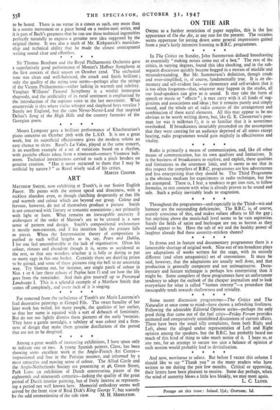ART
MATTHEW SMITH, now exhibiting at Tooth's, is our Senior English Fauve. He paints with the utmost speed and directness, with a reckless abandon even, as though clutching desperately at that life and warmth and colour which are beyond our grasp. Colour and fervour, however, do not of themselves produce a picture. Smith is not concerned with literary or romantic associations ; nor primarily with light or form. What remains an inescapable necessity if arabesques of the order of Matisse's are to be created is a sure sense of pattern and design. Smith's compositional architecture is mostly non-existent, and if his intuition fails the picture falls to pieces. When the Impressionist theory of composition is pushed to such wilful lengths as in, say, Pears and Dahlia, I for one feel uncomfortable at the lack of organisation. Often his colour, riotous and abundant though it is, seems as accidental as the rest, so that one wonders whether it is folly or daring to Put so many eggs in this one basket. Certainly there are dazzl:ng prizes to be gained, and some of these pictures ring the bell in no uncertain way. Try blotting out, for instance, any single patch of colour in Nos. i or 6 (are there echoes of Peploe here ?) and see how the life goes from the remainder. And then give yourself up to Provencal Landscape I. This is a splend:d example of a Matthew Smith that comes off completely, and every inch of it is singing.
* * Far removed from the turbulence of Tooth's are Marie Laurencin's frail decorative paintings at Gimpel Fils. The sweet banality of her later work has veiled, for many people, the qualities of her earlier, so that her name is equated with a sort of debauch of femininity. But do not too lightly dismiss these pictures of the early 'twenties. They have a gentle nostalgia, a subtlety of wan colour and a firm- ness of design that make them genuine distillations of the period that are not to be despised. • * *
Among a great wealth of interesting exhibitions, I have space only to indicate one or two. A young Spanish painter, Clave, has been showing some excellent work at the Anglo-French Art Centre— impassioned and free in the Parisian manner, and informed by a most attractive and moving sense of colour. The Allied Circle and the Anglo-Netherlands Society are presenting at 46, Green Street, Park Lane, an exhibition of Dutch conversation pieces of the eighteenth and nineteenth centuries—lacking the quality of the great period of Dutch interior painting, but of lively interest as represent- ing a period not well known here. Memorial orthodoxy seems well served by the front view of Reid Dick's King George V, but scarcely by the odd proportioning of the side view. M. H. MIDDLETON.


































 Previous page
Previous page